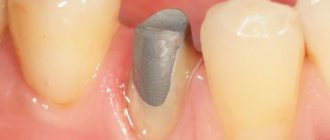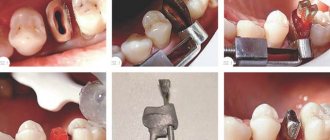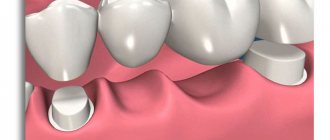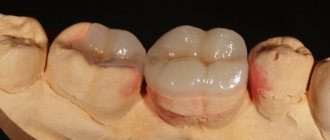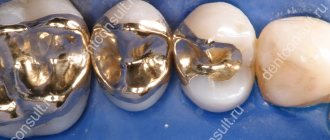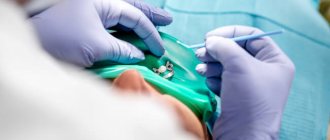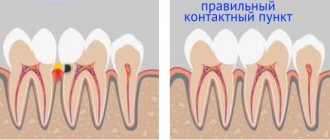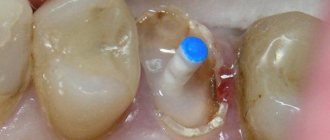Tooth decay has not been a problem for dentists for a long time. In this case, it is not necessary to remove the root and place an implant. If the tooth is at least partially preserved, it can be restored using a pin. This design allows you to grow a new tooth or install a crown, while returning it to its original functionality and appearance. Pin technology is not complicated and quite reliable, so it is often used to solve dental problems.
What is a pin
A pin is a small, durable, rod-shaped structure that is inserted into the dental canal. Outwardly, it looks like a nail or bolt with a thread and a head. It is made of various materials, but mainly metal. Serves as a retainer and holder for an artificial tooth. Used to restore severely damaged or weak teeth.
The pin is a very strong and reliable support for removable and non-removable prosthetic structures. It is inserted directly into the tooth canal and is well fixed in the bone. Thanks to this, the artificial tooth does not collapse, does not break, and can withstand heavy loads. Typically, the pin teeth are the chewing teeth, which are located near the cheeks. But technology allows you to install a pin anywhere in the dentition.
The choice of pins is huge. It depends on the material, size, type of structure, and method of fixation. The dentist must select the best option, because its reliability and durability depend on the condition of the root system and the damaged tooth as a whole. The cost of orthodontic treatment also depends on the type of pin, so the patient’s wishes are also taken into account.
Installation of a pin in a tooth is possible only if it is partially preserved. Complete destruction of the tooth and root requires another treatment method - implantation. The feasibility and possibility of preserving the tooth and its subsequent pinning can only be determined by a dentist or orthodontist after a thorough examination and radiography.
Prosthetics of defects in hard dental tissues using pin structures
Untimely treatment of teeth with a destroyed crown leads to disturbances in the structure of the dentition - this leads to morphological changes and functional disorganization of the dental system.
The longer the pathology exists, the more difficult it is to restore the integrity of the dentition and articulation of balance. There are many methods for eliminating dental defects. Rows when the index of destruction of the occlusal surface of the teeth does not exceed 70 - 80%.
A pin tooth is a structure that is strengthened in the root canal with a pin and is used in case of subtotal or complete destruction of the natural tooth crown, as an independent prosthesis, as well as for fixing bridge-like fixed dentures and for fixing removable dentures (plate, arched structures). They can also be used in combined prostheses (has removable and non-removable parts of the structure).
1728 - Pierre Fauchard proposed the first pin design (consisted of a pin, and the crown was made from the fangs of a sea horse).
The most famous pin teeth are:
- According to Richmand (gold alloy cap)
- Modification according to MMSI (stamped cap)
- According to Kats with supra-root protection and half-ring
- According to Wharton - one-piece construction with a supporting insert
- According to Ilyana-Markasyan - with a supporting part in the form of a cast cubic inlay
- According to Citrin - with a supporting part in the form of a cast inlay: from 2 opposing triangles connected by vertices
- According to Kopeikin - a supraroot stump inlay with a pin, which can be covered with a crown of any type (cast stump pin inlay)
- According to Shargorodsky - with a stainless steel ring and plastic or porcelain lining
- According to Davis - from a porcelain crown and pin
- According to Logan - porcelain tooth with a pin (monolithic design)
- According to Duvel - has a standard porcelain tooth, in which a pin with a special washer is secured
- According to Akhmetov - Me crown with a pin lined with plastic
- According to Parshin - With a metal ring, a pin and a ground standard plastic tooth
There are:
Restorative pin teeth
Supporting
By design:
- Monolithic (cast stump pin insert)
- Composite = combined
By manufacturing method:
- Cast
- Soldered
According to the principle of attachment to the tooth root:
- Pin structures in which the supra-root part only comes into contact with the tooth stump Simple pin tooth
- Standard pin designs (Logan, Duvel)
- Ilyina-Markasyan
- According to Richmand
Basic requirements for the supra-root part of the tooth:
- Reliable isolation of the root from the oral environment
- Strengthening the root wall around the perimeter
Indications for the use of pin structures:
- To restore the coronal part of a tooth in case of its complete absence or significant destruction (when the index of destruction of the occlusal surface of the tooth is more than 80%)
- In case of significant destruction of the coronal part of the tooth, when it is impossible to restore it with a filling, inlay or crown
- To replace teeth located above the dental arch (the teeth are depulped, the crown is cut off and a structure is made)
- As a support for bridges and removable structures
- For periodontal diseases as splinting elements
- For reinforcement of pulpless teeth
Contraindications:
- Untreated pathological changes in periopical tissues
- Root canal obstruction
- Short roots with worn-out walls
- Atrophy of the bone tissue of the alveolar process at the root by ¾ or more
- Destruction of the root by more than ¼ of its length
- A defect in any of the root walls equal to or greater than ¼ of the root size
Requirements for roots:
- The root canal must be well passable along its entire length, or equal to the length of the pin
- The peri-apical part of the equine canal should be well sealed, and the apical periodontium should not show signs of acute or chronic inflammation
- The root must be longer than the height of the future crown
- The walls must have sufficient thickness of at least 2 mm to withstand chewing pressure
- The protruding part of the root should be solid, unaffected by caries
- The root stump should be open if it is covered by gum - gingivectomy
- The root must be stable
There are 4 types of roots:
Tsukanova 1986
- Roots with a preserved supra-anestrial part of 2 mm or more
- Roots at gum level with preservation of walls
- Roots whose edges are hidden under the gum
- Roots with bifurcation destruction
First type of roots.
In those cases, teeth are shown according to Richmand, according to Kopeikin, Katz, Shargorodsky, Davis, Akhmetov, Ilyina-Markasan, Logan, for lateral teeth - only according to Kopeikin.
Second type of roots
Pin teeth according to Ilyina-Markosyan, Citrin, Plastic pin tooth, Orton, Logon, Davis, Yakopeikin can be used
Third and fourth types
Only according to Kopeikin or its modification (in any group of teeth).
Requirements:
- Should not injure the tissues surrounding the root
- It should fit tightly to the surface of the root and thereby isolate its canal well from the moisture of the oral cavity.
- Should be well fixed to the root with a pin
- The pin should enter the canal 2/3 of its length.
- Must meet aesthetic requirements
- It should not interfere with the closure of the remaining teeth and the chewing movements of the lower jaw.
Classification of modern structures:
- Pin structures used for temporary and permanent restoration of the coronal part of a tooth (plastic pin tooth)
- Universal, individually manufactured solid pin structures (according to Kopeikin, composite stump pin inlays)
- Industrially manufactured pins and core inlays (RADIX-ANKER, CYTCO, MOOSER, IKADEENT, C-POST).
- Composite core inlays reinforced with polymer fibers (Ribbond)
- Pin structures for the treatment of root fractures (cast stump pin insert with intra-stump canal and Bragin threaded pin)
- Transdental pins (endodontic-endosseous implants) and parapulpal pins.
Clinical and laboratory stages of manufacturing
For all post tooth designs, it is necessary to prepare the supragingival part of the tooth and expand the root canal. Stump preparation: excision of softened dentin, thin walls and protrusions of the tooth crown. Use: spherical, fissure, flame-shaped burs, shaped heads, separation discs. In order to prevent secondary caries and connect to the root, the affected tissues are ground down to healthy ones.
Using an endodontic set, burs, root drills, and reamers, a bed for the pin is formed so that it is immersed in the canal from 2/3 to ½ of the length of the root. The intracanal part was slightly longer than or equal to the supraroot part, otherwise the tooth could dislocate or split.
Canal preparation: opening the mouth with a spherical bur No. 1. then they are expanded with a fissure-end bur, reamer, and fissure burs of the appropriate diameter. It is advisable to create a bed for the pin with a gradual increase in the diameter of the cutting tool, directing the tool according to the location of the channel. Extension is carried out under x-ray control. The root walls must have a thickness of at least 1 - 1.5.
The thickness of the pin depends on the strength properties of the alloy used. Most often 750 gold, stainless steel, Co-chrome alloy, silver-paldium. The thickness of the pin is at least 1 - 1.3 mm. The optimal thickness is 1/3 of the diameter of the tooth root.
The main criteria for choosing a pin are the shape:
- Cylindrical. The simplest and have the best retention. But their shape does not coincide with the shape of the tooth root. They cover fragile areas, the risk of perforation of the tooth root. Indicated for short and massive roots.
- Tapered pins. Retention decreases as the cone angle increases. They are adapted morphologically and the pressure at the level of the apex of the tooth root is less significant when they are cemented. But due to their shape they cause a feeling of wedging. They are more durable, but less stable
- Cylindrical-conical pins. Pins are of an intermediate type, stronger than cylindrical ones in the apex area, and more stable than conical ones due to their cylindrical part.
An important factor for retention is the condition of the pin surface.
There are:
- Smooth pins
- Grooved pins
- Screw threaded pins
- Combination pins
Plastic pin tooth
Or a simple pin tooth. This is the simplest design. In prepared k.k. a pin made of clasp or orthodontic wire with a diameter of 1 – 1.8 mm can be used; a standard metal pin can be used. When using wire, the supragingival part is made in the form of a loop.
After this, an impression is obtained, with the pin moving into the impression. The model is being made. Next, the crown is modeled using wax (according to the requirements for plastic crowns). Then the wax is replaced with plastic. The pinned tooth is processed, polished and prepared in the oral cavity at the clinical stage and fixed with cement.
Now plastic teeth are used as temporary structures.
Fast-hardening plastics can be used. This simplifies and speeds up prosthetics. Production in 1 visit.
The pin is fitted in the oral cavity and the crown is modeled using cold polymerization plastic; celluloid caps can be used, or provisional standard crowns can be taken. After hardening, the pin tooth is removed from the root, ground, polished, and then attached to cement.
The plastic can swell in the mouth and this can cause the root to split.
Advantages:
- Simplicity
- Cheapness
- Relative aesthetics
Flaws:
- Resorption of cement
- Pin breakage
- Breakage of the supragingival part
- Plastic color change
- Richman pin tooth
- Rarely used.
The design consists of a ring and a supra-root protective plate. It is made of 900 gold alloy, the thickness of the cap is 0.25 - 0.28 mm. The height of the ring is 4-4.5 mm.
After receiving the ring, an impression is taken, the plate is welded and a cap is obtained, then the cap is installed in the oral cavity.
Richman pin tooth
Belongs to group 3.
Richmand suggested making them from gold alloys, now from stainless steel.
Development of the k.k - the Me plate is taken, adjusted in relation to the periodontal groove and the diameter of the tooth root, soldered it - we get a ring (nowadays it is not made like that). An impression is taken on the model, the cap is soldered, soldered - you get a cap that is fitted to the tooth stump. To determine the location of the KK, the cap is filled with softened wax. At a clinical appointment, a hole is made in the area of the impression on the surface of the cap, a standard pin is fitted into the joint, the impression is taken, the cap and pin go into the impression. Soldering the cap and pin. A standard ceramic facet (standard tooth) is taken, installed on the inner surface of the crown, an oral protection is modeled from wax, it is replaced with metal, then the cap is soldered to the protection. To fix the facets, the clamps are flattened with a hammer, they are on the surface of the protector, or on cement.
When using plastic, pearls are used instead of holes.
Grinding, polishing. Fixation with cement.
Due to the falsity of manufacturing a soldered cap, a design with a stamped steel cap has become widespread - a pin tooth according to Richmand in the MMSI modification. The protective cap (the main advantage) is made by casting; soldering is excluded. Protection from saliva, caries and de-cementing.
Pin tooth according to Akhmedov.
The root is prepared in compliance with all requirements for a full metal crown. The tooth stump should protrude above the gum level to ensure a tight fit of the crown edge. A stamped ME crown is made. A standard pin is fitted and the oral wall is perforated in the projection of the root canal. Then taking the impression. The pin is made of stainless wire.
An impression with a pin is obtained and the color of the plastic is determined. In the laboratory, a model is obtained, a pin is soldered to the crown and a window is cut out on its vestibular surface. Wax modeling, replacement with plastic. After veneering, a crown with a pin is placed in the mouth.
According to Ilina-Markasyan
The coronal surface is contacted using a flush surface. It is destroyed towards the core and a cubic cavity is formed under the tab, a pin is installed and the cavity is filled with wax to the edge of the root stump, replacement of wax with Me and the pin is inside the tab, fitting on the model and taking an impression. The model shows modeling of the oral protection and creation of retention points (loops or pearls). The Me protection is soldered to the root protection, grinding and polishing of the Me, modeling of the vestibular surface and replacement with plastic.
Consists of a wire pin and a cast cubic inlay. Rotation of the pin and hermetically sealed closure of the canal are eliminated; there is no access for saliva.
Stages 6
- Preparation of the canal and root surface.
- Forming a cavity for the tab
- Expansion of the channel and fitting of the pin
- The protruding part of the root is ground down to the level of the gums
- The formed cubic cavity is modeled using a direct method using softened wax, an inlay with a protector.
Then in k.k. a heated pin is inserted; the free end, which will be located in the area of the inlay, must be deformed and flattened so that when replacing the wax with Me there is a good connection.
Excess wax is removed and transferred to the laboratory (foundry)
The cross section of the tab is 2 – 3 mm.
Fitting the tab and protective plate with a pin. An impression is taken of the entire dentition; at the laboratory stage, a model is made, onto which the pin, inlays and protection are transferred. The oral and vestubular surfaces are formed.
Positive properties:
- Chewing pressure is transmitted through the entire root surface
- There are shock-absorbing properties due to the cubic tab
- The inlay prevents cement resorption
Negative properties
It is impossible to use the structure with thin root walls; the root may split under horizontal load.
Logan-Davis crown
Standard porcelain crown with a hole for the pin and the Me pin itself. First, a crown is selected according to color, size and shape, and the structure is fitted to the root of the tooth so that the transition between the artificial crown and the tooth tissues is not visible. The crown fits for insulation. Connecting the crown to the pin and fixing it with visphat cement.
Pin tooth according to Citrine
He proposed a tab in the form of two opposing triangles connected by vertices. This is considered to be a more stable design and requires less preparation of the side walls. This design may include 2-3 parapulp pins.
Cast stump pin inserts.
For single- and multi-rooted teeth.
For single-rooted teeth.
Manufacturing in 2 ways (directly in the oral cavity, in the laboratory on a model)
Developed by k.k. in the oral cavity for 2/3 of the length of the root, the formation of a cavity under the tab is mandatory. Mb is used if the root is up to 1 mm below the gum level. Then a stump is made depending on the type of structure that will be created later. Replacing wax with Me.
With the laboratory method. First, taking a silicone impression with a 2nd impression using the sandwich method (even from the canal).
It is a one-piece structure consisting of an artificial stump of the coronal part of the tooth, an intra-root pin/pins, an inlay, and can be covered with a stamped, cast or other crown on top.
In size and shape, the stump should correspond as closely as possible to the stump of a natural tooth after its preparation for the crown of the chosen design
Advantages:
- Can serve as a supporting element of fixed and removable dentures
- Allows you to restore most tooth roots, both single-rooted and multi-rooted.
- Possibility of repeatedly replacing an artificial crown without removing the stump (when removing an adjacent tooth, the outer crown can be removed and the stump can be used again, but without removing the bridge support)
- Possibility of restoring teeth damaged below the gum level
- Possibility of restoring multi-rooted teeth with corroded roots
- Prosthetics with bridges supported on the roots of the teeth is facilitated, since the stump compensates for the non-parallelism of the root canals and the inclination of the tooth itself
- When restoring teeth with pathological abrasion
Root preparation depends on the degree of crown destruction. For all types of roots, one design can be used.
- Complete suturing of the damaged crown
- Gentle preparation
Always remove thin and softened walls to strong, unaffected structures.
The expansion of the canal is carried out taking into account the anatomical structure of the root and its thickness.
To prevent rotation of the pin, an oval or cubic cavity is formed. In the front teeth, it is necessary to avoid thinning the labial wall, and in the lower teeth, the lingual wall, because the pressure when closing the teeth will be distributed precisely on these surfaces.
The thicker and longer the pin, the greater its surface area, and therefore the greater the adhesion between the pin and the root, carried out through cement.
When expanding the canal, it is not recommended to thin the wall by more than 1.5 mm, an exception for the lower incisors and second prepainters, since the load will coincide with the longitudinal axis of the tooth.
The formation of the channel is carried out taking into account the shape of the channel itself and the direction of pressure. For flattened roots, the orifice is expanded in the vestibular direction to form an additional cavity in the orifice, but with a depth of no more than 2 mm.
The angle of toe (convergence) is important for the stability of the pin and should not exceed 3 degrees (1984 Kalamkarov)
After preparing the root, they begin to manufacture an artificial stump with a pin. The most widespread method of manufacturing is the direct method of inlays. It consists of: the root prepared under the stump is isolated from oral fluid. The cavity for the pin is cleared of sawdust with a stream of air, then its channel walls are moistened with wrung-out cotton wool (water). A stick of modeling wax (lavax) is heated to a plastic state so that it can change its shape. It is better to heat it in water than on an alcohol lamp, so that there is no tension in the wax and there is no further deformation. The wax is given a conical shape or the appearance of a pin and the wax is pressed into the canal so that the wax fills the entire prepared root canal and gives a good impression of its surface. Through the wax covering the root surface, a metal rod with a diameter of 1 or 1.5 mm made of elastic steel wire is inserted into the canal. Before this, the pin is heated over a burner flame to the melting temperature of the wax. When creating a stump of molars or a premalar, 2-3 pins are used. Pins should be placed in multi-rooted teeth so that the longer pin is positioned in a thicker walled root in a better traversable canal. After preparation of the canal roots, they should be parallel, but most often this is not possible due to possible perforation of the root wall.
Disadvantage of this classic method:
Using wax and introducing steel wire there, after manufacturing the wire will remain, after heating in a muffle furnace it will be annealed, the wire will become soft and the disadvantage is that different metals will be combined in the structure
Cool with a stream of cold water and remove the workpiece from the channel. The coincidence of the tips of the wax pin and the wire means that the roots of the canal are well traversed and a negative image of the canal is obtained along its entire length. For wide, well-traversed channels, wire may not be used.
Then an artificial stump is modeled, the shape of which depends on the future crown. To do this, using modeling spatulas, create the direction, the necessary gap between adjacent teeth and antagonists, rounding the corners, create some narrowing in the direction of the cutting edge, and also form a ledge according to indications. The simulated stump pin insert is removed from the root canal, placed in a vessel with cold water and transferred to the laboratory for metal casting.
Plastic manufacturing method
For this purpose, self-hardening ashless plastic is used. First, a standard plastic pin is fitted according to the diameter and length of the root, which should freely enter the root canal along its entire length. Lubricate the walls of the canal with Vaseline, stir the self-hardening plastic and use a syringe to fill the canal with it and insert a plastic pin.
There is also a method when plastic is introduced into the canal using a brush and applied to the cavity on the formed sublining. The supra-root part of the pin is covered with plastic and a stump is formed for the required structure.
Rub the rubber with a brush. A monomer (liquid) is applied to the brush, the tip of the brush with the monomer is lowered into the powder or polymer, and at the tip of the brush the powder is saturated with liquid. With this brush, plastic is introduced into the canal and a tooth stump is formed with it; after the plastic has hardened, additional preparation of the stump and hard tissues of the tooth is carried out, and a ledge is created. Plastic is processed using cutting tools. Preparation taking into account the future design.
The plastic blank is sent to the laboratory to be replaced with metal. Ashless plastic burns out completely in a muffle furnace.
The advantage of this method compared to using wax: the plastic structure is not deformed during removal from the canals and during transportation, they better display the relief. (plastic kit includes ashless pins, insulating petroleum jelly)
Indirect manufacturing method.
The canal is prepared, a cavity is created for the inlay, and the 2nd silicone impression is taken (extra eraser, alpha force, exaflex, stomaflex). Using a canal filler, we inject the impression correction mass into the canal, then, using a syringe, inject the impression mass into the cavity formed under the inlay. The assistant kneads the mixture and puts it into a spoon. And in the end, the sandwich method is removed. Based on the impression obtained, a working model is cast from heavy-duty plaster or a fire-resistant model, on which the wax composition of the stump inlay is modeled, and then it is cast from Me (casting or on a fire-resistant material, or if the model is plaster, then it is cast with removal from the working model)
When fitting the cast inlay, a tight fit is achieved, after which sandblasting is carried out so that the surface is rough and fixed with cement, followed by additional preparation of the tooth and the manufacture of an artificial crown.
Restoration of the destroyed crown of multi-rooted teeth is carried out using composite stump pin inlays. Difficulty: impossibility of using most known designs of pin teeth, lack of parallelism between the canals.
You can use a classic cast stump insert or several of them or a collapsible design
A composite core may consist of 2 or more parts so that these parts are not separated by connecting them with a lock or dovewing. Milling of the first obtained part is carried out taking into account the direction of the distal canal. Next, the second part is modeled from ashless plastic to better represent the fastening. And we get a structure that is firmly connected and fixed to cement.
The production of cast cul pin inlays is conveniently carried out in the laboratory. First, the root canals are prepared, the hard tissues of the tooth are excised, a cavity is formed under the LCS inlay, this is done in the oral cavity - standard pins and self-hardening plastic are taken and the tooth stump is formed. You get a reproduction of the insert made of plastic and replaced with metal. Fitting is carried out, the tightness of fit and fixation to cement is assessed.
Selecting an alloy for the manufacture of stump inlays
Qualities:
- Bioinertness
- Hardness
- Ability to withstand deformation loads
- Low casting shrinkage
- Low thermal conductivity coefficient
Noble:
- 750 gold alloy containing 10% platinum
- Silver alloy
- Silver-palladium alloy
Ignoble:
- Chrome-nickel alloy
- Chromium-cobalt alloy
- Titanium
- Steel
From the point of view of bioinertness, titanium is preferable
Silver and silver-palladium alloys have bactericidal properties, but their use causes pigmentation of the gums surrounding the tooth (especially when healthy tissues below the gum level are destroyed)
Chromium-nickel alloys – high shrinkage, cytotoxic effect of nickel.
Cobalt-chromium alloy – high hardness, low shrinkage, difficult to process
| Standard pins (anchor) | Stump inlays |
| + More gentle preparation of tooth tissue Possibility of treatment in 1 visit Low cost It can be unscrewed from the canal if necessary – Inside, the root and crown parts of the structure can separate, since there is no chemical connection. When active pins are used for restoration, a wedging effect occurs when the pin is screwed in. There is no supporting platform - this can lead to wedging | + The pin and stump are single and cast from the same material, which eliminates the risk of their separation Minimization of wedging loads, since chewing pressure is transmitted not only to the pin, but also to the inlay. When cementing an inlay, there is a small wedging effect, low pressure on the tooth – More extensive preparation due to the need to remove everything from the inside of the tooth cavity Longer production time, minimum 2 visits Preparation of the stump for a crown is possible only at the next visit High price |
Gold alloys are more convenient because the material has minimal shrinkage and is easy to process.
In what cases is it permitted and prohibited to install a pin?
A tooth destroyed by caries or mechanical damage does not always require the installation of a pin. In some cases, restoration measures are sufficient, especially when it comes to the front teeth. To restore a tooth using pin technology, there must be certain strict indications, which include:
- destruction of the crown part of the tooth by more than 50%;
- the need for support for removable and fixed dentures;
- absence of the outer part of the tooth with complete preservation of the root;
- stopping subsequent tooth decay after treatment of serious carious lesions;
- tooth restoration after surgical treatment of periodontal pathologies;
- saving a tooth after treatment for infectious diseases of the oral cavity.
The pin is installed only if the tooth walls are preserved by at least 15-20% and the root thickness is at least 2 mm. If for some reason this is not possible, then an alternative recovery method is selected.
The use of a pin for dental prosthetics also has its contraindications. These include:
- serious untreated carious damage to the walls of the tooth;
- damaged or very thin tooth roots;
- impossibility of clearing dental canals to at least 1/3 of the depth;
- insufficient root canal height;
- granuloma and cyst of the jaw in the acute period;
- chronic periodontal pathologies;
- problems with blood clotting;
- pregnancy period;
- neuropsychiatric diseases;
- history of allergic reactions to implants.
Only taking into account all the indications and contraindications is it possible to choose the right technology for treating a decayed tooth. Installing a pin involves certain restrictions that cannot be ignored by either the patient or the doctor.
Indications and contraindications
Before moving on to the indications and contraindications for this method, it is necessary to understand the question of what a dental pin is. We are talking about a structure in the form of a rod, which is placed in the root canal as a support for a crown or bridge. Such products can also be used to strengthen the root system of a partially destroyed tooth during its restoration with composite material. Thus, among the main indications for their installation, experts highlight severe destruction of the crown, removal of a nerve during the treatment of deep caries or pulpitis, and the need to install an artificial crown or bridge.
Design in the form of a rod, which is placed in the root canal as a support for the crown
On the Internet you can find quite a lot of queries about what to choose – a dental post or an implant, but these are two completely different concepts. The pin is installed in the canal in order to preserve the root system, while the implant serves as a full-fledged analogue of the root - it is implanted into the jawbone in the absence or need to remove the latter.
However, it is not possible to install a pin in all cases. Among the contraindications to its use are insufficient thickness of the root walls, the presence of cysts and granulomas in the root region, severe curvature and obstruction of the canals. If there are inflammatory processes in the oral cavity, the procedure is possible only after undergoing appropriate treatment.
Types and types of dental pins
The pin is not a stable structure; it is selected to suit the individual needs of each patient. For this purpose, different types of pins have been developed, which are indicated for a particular pathology. First of all, there are several materials for making a dental rod. Depending on this, pins are divided into two types - metal and non-metal.
- The metal pin is made of metal alloys. Titanium, brass, gold, steel, palladium are used. It is difficult to find a pure gold or titanium pin, and it will be expensive. Most often there are compounds in which one or another metal predominates. The choice usually depends on the purpose of the pin, as well as the individual body's reaction to the material. All metals are inherently hypoallergenic, but cases of hypersensitivity do occur. For severe allergies, a pin with gold impurities is perfect. In case of significant tooth damage, it is better to take titanium - the strongest and most durable material that can withstand heavy loads. But it is not plastic, so it can damage the root under strong pressure. You need to inform your dentist about all your peculiarities in order to adequately select the material and then not redo the tooth.
- Non-metallic pins involve the use of carbon fiber, ceramics, and fiberglass. Carbon fiber is a very plastic material, but is rarely used in dental practice due to its low strength. And the pin should serve as the main holder of the artificial tooth.
- Ceramic knitting needles in the tooth are very aesthetic. They do not show through the crown and are not visible even upon close examination. At the same time, ceramics cannot boast of strength and wear resistance. It is advisable to use a ceramic pin on teeth that are visible when smiling and are slightly involved in the chewing process.
- The best option according to all criteria is fiberglass. This material is plastic, flexible, lightweight and completely transparent. Under heavy load, such a pin bends and then returns to its original state without damaging the walls and root of the tooth. Externally, the design is absolutely invisible, so it is suitable for any teeth.
Non-metallic structures are used by dentists much less often than metal ones, mainly due to the high cost of prosthetics.
The method of attaching and fixing the pin in the jaw plays an important role. There are two main types of pins:
- active;
- passive.
The active design implies the presence of grooves (like the threads of a bolt), thanks to which it is screwed into the bone tissue. This ensures maximum reliability and immobility. This restoration method is suitable for non-expanded dental canals. When properly installed and secured, the active pin lasts for decades without moving or breaking.
Passive pins are used less frequently and are indicated for the treatment of severely damaged teeth. A large hole in the tooth will not hold an active structure, so a passive one is used. It involves filling the cavity with cement into which a pin is inserted. Installation is simple and quick, but less reliable and durable.
The appearance and shape of the dental post also varies. The most popular and popular conical and cylindrical designs, which are considered standard. But in different situations it may be necessary to select a more exclusive form. For such a case, cylindrical and screw pins were invented. The choice depends on the characteristics of the channel and the size of the hole.
A separate group includes individual pins, which are made in a single copy for a specific person. Such a knitting needle exactly follows all the bends and expansions of the dental canal, ensuring reliable fastening of the crown.
Clinic doctors
If the crown part of the tooth is destroyed by more than 50%, but the root is intact, it is not at all necessary to remove it. In such cases, modern dentistry successfully uses tooth restoration using a pin. This technique is actively practiced at the DentaBravo clinic, whose specialists are fluent in all its techniques.
What are pin structures?
These are various rods made of metal or other material that are fixed in the root canal and serve as support for a permanent bridge or artificial crown. The installation of a dental pin is used in cases of significant or complete destruction of the natural crown of the tooth, provided that its root is absolutely healthy.
What types of pin structures are there?
There are therapeutic designs, when the doctor uses standard dental pins, manufactured industrially in a factory, and orthopedic designs - such pins are made individually based on a cast of the patient’s tooth.
When are therapeutic pin structures used?
When reinforcing pulpless, partially destroyed teeth in cases where it is not planned to use an artificial crown. For the restoration of single-rooted teeth in which the pulp has been removed for orthopedic reasons (under metal-ceramic crowns).
What are the disadvantages of therapeutic pin designs?
The main disadvantage is the low strength of the connection between the therapeutic pin structure and the tooth root.
What are the types of therapeutic pins and features of their use?
There are several types of dental posts:
- Metal (anchor pins) made of steel or titanium. They have increased strength and are used in the reconstruction of severely damaged teeth.
- Carbon fiber, glass fiber: the elasticity of these pins is close to the natural elasticity of dentin, thanks to which they give the restoration maximum strength and reduce the risk of root fracture. They are also more aesthetically pleasing and are used to reconstruct anterior teeth.
When are orthopedic pin structures used?
Individual production of a pin structure is indicated when it is necessary to reconstruct a crown in its complete absence or a severe degree of destruction, that is, in cases where it is necessary to restore the stump and make an artificial crown, as well as when creating a support for a bridge.
Advantages of orthopedic pin structures?
Individual orthopedic pin designs are much more reliable than standard pins. Made taking into account all the features of the relief of a particular root, they are perfectly retained in the root canal, and therefore allow you to restore a tooth even in the most difficult cases.
What are the types of orthopedic pin structures and features of their application?
Orthopedic pin structures differ in the material from which they are made, and can be metal or ceramic. The metal structure perfectly withstands heavy loads, so it is used to restore chewing teeth. Ceramic post structures are more aesthetically pleasing, which is why ceramics are mainly used for restorations in the smile area.
What are collapsible and non-dismountable orthopedic pin structures?
Collapsible structures consist of two separate parts that are connected during installation. As a rule, they are used to restore teeth with two or more roots. Non-removable pins have a monolithic design and are used for the restoration of single-rooted teeth.
What are the quality criteria for pin structures?
The clinical effectiveness of restorations using post structures directly depends on the qualifications of the specialist and the quality of the materials used. If all stages of prosthetics are performed correctly, there should be no complications, such as decementing of the pin, disruption of the fixation of the artificial stump material, or fracture of the root of the abutment tooth. The pin in the tooth should also not cause inflammation of the gums, the presence of recurrent caries of the root and crown parts, progression of bone atrophy in the neck area and other unpleasant phenomena.
What is the cost of pin structures?
It is difficult to give a definite answer to this question, since the price of prosthetics depends on factors such as the degree of tooth destruction and the chosen design. You can find estimated prices on this page, and to find out the exact cost of treatment, make an appointment at our clinic.
What are the advantages and disadvantages of pins?
To make the optimal choice of orthodontic design, you must weigh all the pros and cons of installing a pin in the tooth. After all, you will have to live with this for many years, preferably without discomfort and all sorts of complications.
A tooth that is more than half destroyed cannot be restored or filled, especially if it is chewable. In this case, the only way out is complete removal and placement of the implant. But dentistry has come up with an ideal alternative to both operations - a pin tooth. It is less painful, less time-consuming and much more economical. This is the main advantage of the pin.
But this is not all the advantages. In addition to saving a hopeless tooth, pins:
- do not damage or violate the integrity of neighboring teeth;
- suitable for installation anywhere in the dentition;
- allow you to restore a damaged tooth almost from scratch, returning it to its original appearance;
- have a long service life - from 10 to 20 years;
- are made from different materials, which allows you to choose for each individual case;
- withstand heavy loads when chewing food;
- completely restore the functionality of a damaged tooth.
Like any dental structure, pins have some disadvantages. After constant significant loads, they can gradually destroy the tooth root and crown, which will ultimately lead to its complete removal. The inelasticity of some materials contributes to this. Sometimes caries develops around the knitting needle, which cannot be seen during examination. This situation is excluded if the installation was carried out efficiently and professionally.
Very rarely, a pin can cause an allergic reaction followed by rejection. In this case, you will have to remove it and replace it with another material or install an implant. And, of course, the price for installing a pin is not small, so you need to be prepared for significant expenses. Although, a beautiful smile and lack of discomfort are worth it.
In any case, the advantages of the pins are much greater than the disadvantages. And the selection of a tooth restoration method remains up to the doctor. In most cases, it all depends on the specific situation and the severity of the tooth problem. Trust professionals who know what is best for your teeth.
previous post
Important recommendations after tooth extraction: food, drink, alcohol, smoking
next post
